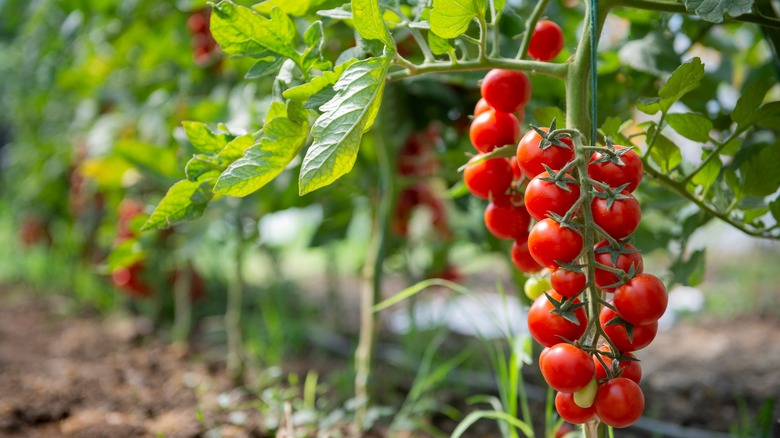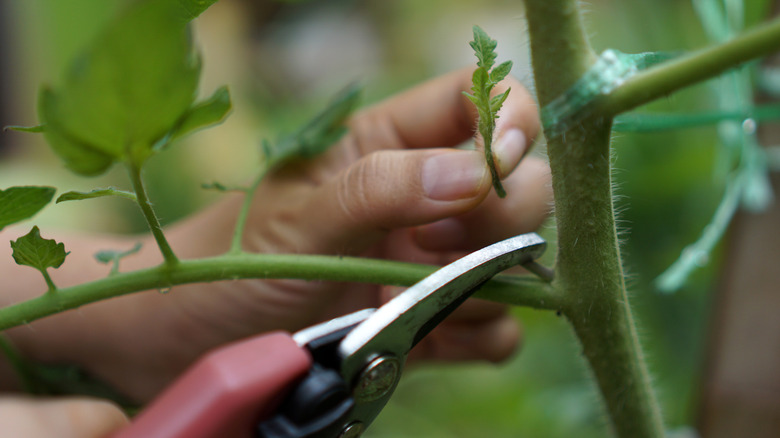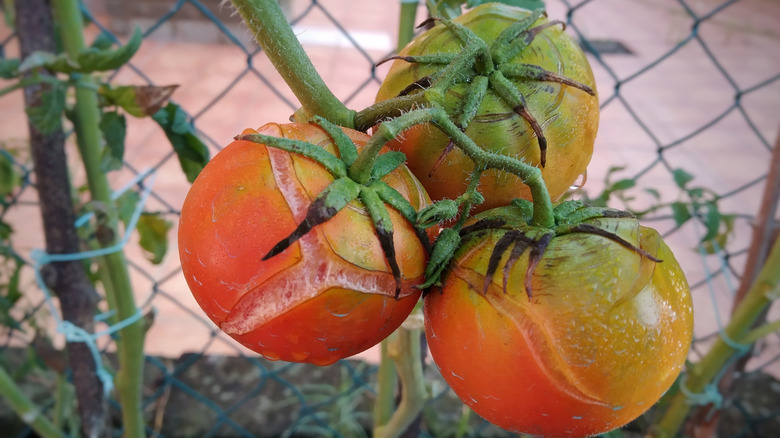How To Prune Your Cherry Tomato Plants To Keep Them Healthy And Productive
The burst of sweet and tangy tomatoes fresh from the vine can't be beat. To ensure you'll get plenty of these moments this summer, you need to keep your plant well-pruned to improve fruit production. Allowing your plant to grow freely results in too many leaves and small tomatoes; pruning will allow the plant to direct its energy towards what matters, which is delicious fruit. Removing suckers and unneeded fruit are guaranteed to get you the bountiful harvest you're after.
Knowing what to prune is half the battle; the other half is knowing when. Pruning at the wrong time is one of the crucial mistakes to avoid when pruning tomatoes, which can be a detriment to your plants. Begin pruning when the first flowers have opened, which should be in late June or early July, depending on where you live and when you transplanted your plants. Always use clean shears and prune when the plants are dry to avoid spreading diseases.
Remove suckers and leaves to keep tomato plants tidy
Tomato plants start with one main stem and grow suckers that eventually turn into more main stems. Indeterminate tomatoes are a kind of plant that will grow more suckers and fruit until the frost kills them. Many cherry tomatoes are indeterminate, and though they have small fruit, the plants can become quite large. You can control these fast growers by removing suckers as they show up and limiting the plant to two main stems. This method is sometimes referred to as the Y method; you leave the first sucker on the main stem and keep the plant pruned so that the two main stems form a Y. When growing tomatoes in cages, you can have up to four main stems. It will reduce the chance of fruit developing sunscald because of all the foliage, but more stems could mean more diseases thanks to higher humidity around the plant.
Along with pruning suckers, removing the bottom leaves on the plant will prevent diseases from spreading, including early blight, anthracnose, and leaf spot diseases. Soil-borne diseases can splash onto plants when you water them or when it rains, but if the bottom leaves aren't there, you can greatly reduce the chances of your plants getting infected. For the best results, remove the leaves on up to 12 inches of the plant or until the first set of fruit.
Remove ripening or ruined fruit to focus energy
It may sound counterproductive to prune fruit off of a tomato plant, but it can actually help you achieve the fruitful harvest you're hoping for. Remove tomatoes once they begin ripening so the plant can focus its energy on growing more fruit. Energy spent on ripening tomatoes is basically wasted since those tomatoes will continue ripening on their own off the vine. By removing ripening tomatoes from indeterminate varieties, you're giving the plant much more time and energy to create even more flowers and fruits for you to enjoy. House Digest's Master Gardener Tiffany Selvey cautions, "This rule does not apply to determinate cultivars, since these plants only produce a set number of fruit during their lifetime. Removing stems and blooms from these types will reduce your overall harvest."
You can also remove diseased or injured fruit, as well as the fruit you don't intend on eating for one reason or another. Rather than letting it stay on the plant and turn red, remove it and throw it away so the plant can keep growing edible fruit you'll enjoy. If a tomato is only injured and not diseased, you can compost it. You can reuse split tomatoes by leaving them on the ground for pests to eat so they'll stay away from the good fruit up top.


